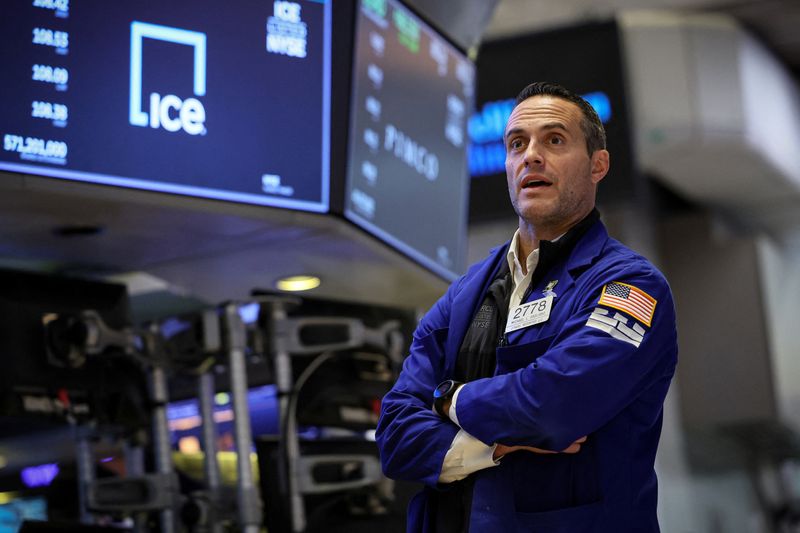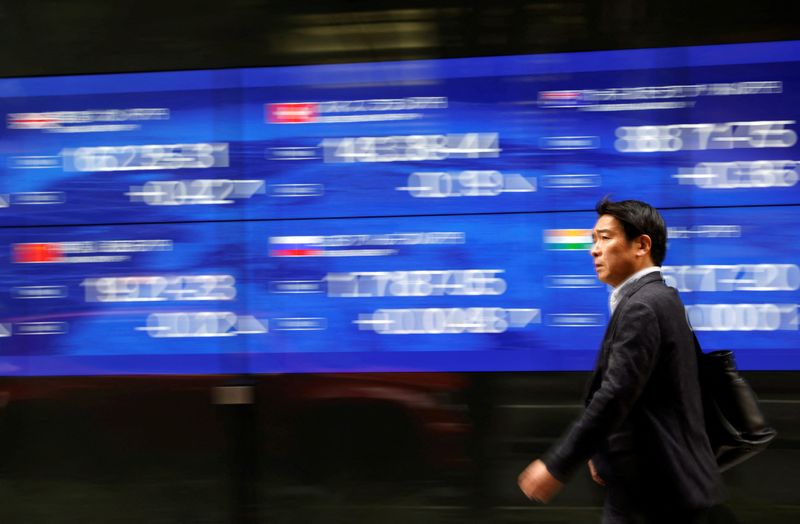By Herbert Lash and Amanda Cooper
NEW YORK/LONDON (Reuters) -Global shares fell on Tuesday, crushed by a fresh surge in Treasury yields after U.S. job openings rose more than expected in August, in another sign of a resilient economy that points to the Federal Reserve keeping interest rates higher for longer.
The dollar initially rose but later fell sharply against the yen after breaching the key 150 level for first time since October 2022, leading some to suspect intervention by Japanese monetary officials to halt the yen's fall.
Japan's finance ministry did not respond to requests for comment. But the dollar's sharp move lower was hard for the market to ignore.
"It has all the hallmarks of intervention in all honesty," said Michael Brown, market analyst at Trader X in London.
Others in the market disagreed, saying the breach was due to the strong Job Openings and Labor Turnover Survey, or JOLTS report for August, which snapped three straight monthly declines. Employers also held on to their workers in August.
"U.S. economic strength continues to surprise on the upside," Ronald Temple, chief market strategist at Lazard (NYSE:LAZ) in New York said in comments to media.
"The Fed's rate hike cycle is likely over, but data like today's pose the risk that one more hike might be needed."
The 10-year Treasury note surged more than 12 basis points to hit 4.806%, its highest yield since August 2007. The dollar fell 0.71% to 149.165 yen hovered near break-even against the euro. The dollar index was little changed at 106.97.
Major U.S. and European stock indexes fell more than 1%.
MSCI's gauge of stocks across the globe shed 1.49%, and the pan-European STOXX 600 index closed down 1.1%.
On Wall Street, the Dow Jones Industrial Average fell 1.43%, the S&P 500 lost 1.53% and the Nasdaq Composite dropped 2.06%.
Rising bond yields have yet to show signs of slowing the U.S. economy more than would be expected in a typical tightening cycle, said Atlanta Fed President Raphael Bostic, the latest Fed official to discount the market-driven spike in borrowing costs.
Even though Bostic agreed that recent jumps in long-term yields have been unusual, he joined several of his colleagues in downplaying their relevance to policy - at least so far.
Analysts see bonds, whose price moves inversely to yield, sustaining further weakness until there are clear signs that higher borrowing costs are hurting the economy.
The yen is a particular casualty of the dollar's march to 10-month highs and the rise in Treasury yields, given a yawning gap between U.S. and Japanese interest rates.
Monetary authorities in Japan are sticking with a policy of keeping borrowing rates extra low, removing an incentive for investors to own the country's currency or its bonds.
The 10-year Treasury's yield now boasts its largest premium over their Japanese counterparts since last November at nearly 400 basis points.
Traders are attaching a 27.7% chance of another U.S. rate hike in November and a 46.3% chance of an increase by December, according to CME Group's (NASDAQ:CME) FedWatch Tool. Futures now show the Fed's lending rate staying above 5% through September 2024.
SENSE OF URGENCY
Japanese Finance Minister Shunichi Suzuki said on Tuesday authorities were watching the currency market closely and stood ready to respond, repeating a warning against speculative moves that did not reflect economic fundamentals.
In the last week, Suzuki has said authorities are watching the yen with either a "high" or "strong" "sense of urgency" seven times.
Oil prices recovered after hitting a three-week low as investors weighed a stronger dollar, darkening global economic signals and tightening supply.
U.S. crude futures rose 41 cents to settle at $89.23 a barrel, while Brent settled up 21 cents at $90.92.

Gold prices languished near a seven-month low, weighed down by a robust dollar and elevated bond yields as the likelihood of U.S. rates staying higher for longer dominated sentiment.
U.S. gold futures settled 0.3% lower at $1,841.50 per ounce.
